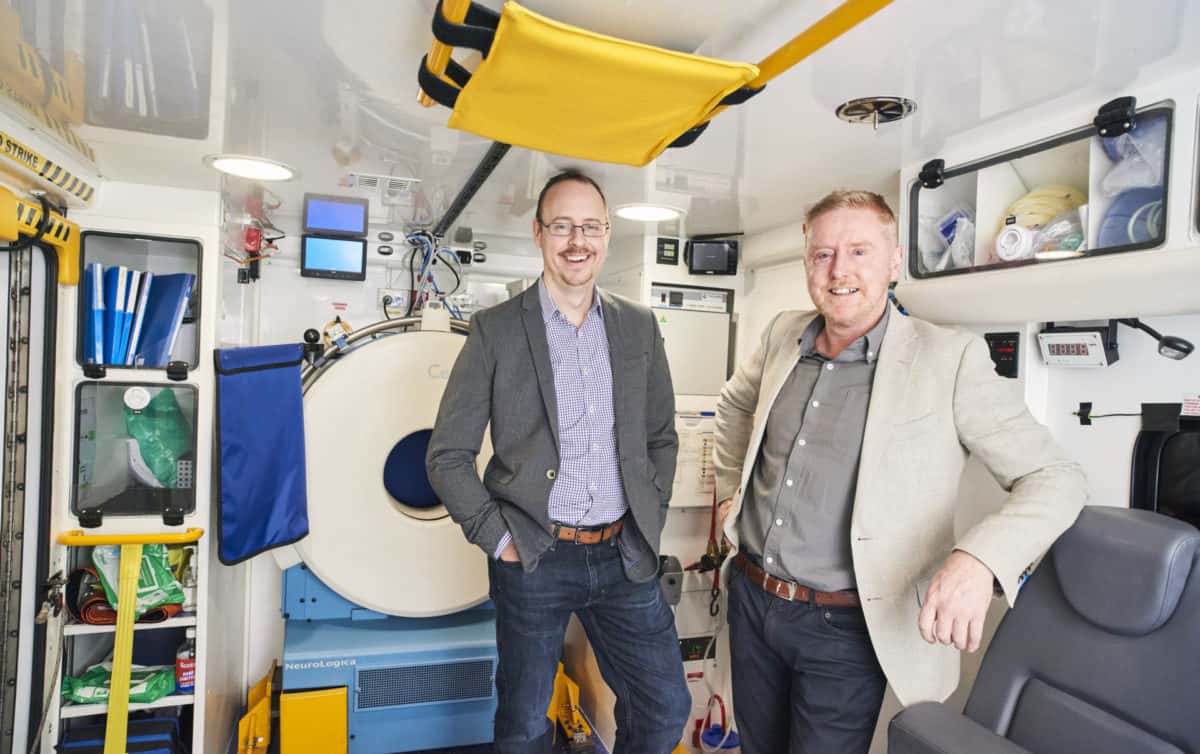A new generation of clot-busting medication may lead to a change in standard medical practice in stroke treatment centres around Australia, thanks to research being conducted onboard Melbourne’s specialist stroke ambulance.
It is hoped the research will lead to life-changing outcomes for people with ischaemic stroke (85% of all strokes) who require a clot-busting medication within a strict treatment window – in a range of settings including specialist stroke centres and emergency departments.
The two-year study, led by the University of Melbourne (and including Melbourne Academic Centre for Health (MACH) partners Austin Health, The Florey Institute of Neuroscience and Mental Health, Melbourne Health, St Vincent’s Hospital Melbourne, and Western Health) is still in progress and is expected to complete recruitment and follow-up by the end of 2021. Patients are CT-scanned in a specialist stroke ambulance. When diagnosed as requiring thrombolysis, patients may receive a potentially more effective clot-buster, Tenecteplase. Tenecteplase, is chemically related to a protein that is found in the blood called tissue-plasminogen activator, and binds to blood clots and dissolves them rapidly, removing artery blockages and returning blood flow to the brain.
The trial on the Melbourne stroke ambulance is the first pre-hospital trial of Tenecteplase for stroke in the world.
Tenecteplase, given as a standard dose in an injection, is being trialled ahead of its cousin, 25-year-old alteplase, which requires a time-consuming one-hour infusion and has been found to work for only 30 to 45 per cent of patients.

As well as being easier to administer, tenecteplase is less expensive, safe, and effective,” says project lead, Associate Professor Andrew Bivard, a grant recipient with the MACH and the chief technology officer with the Australian Stroke Alliance who is based at the Melbourne Brain Centre at the Royal Melbourne Hospital and at the University of Melbourne.
Given the adage ‘time is brain’, the fast administration of the newer drug in the ambulance and at the scene of the stroke, means the first responders are offered the best chance to dissolve the clot, well before transporting the patient to hospital. The ideal window for thrombolysis treatment is 90 minutes from the stroke onset, making the stroke ambulance an invaluable resource as earlier treatment saves more brain. Indeed, the Melbourne Stoke Ambulance is now treating up to 20% of patients with the first ‘golden’ hour after stroke onset.
The specialist ambulance has been described as an emergency stroke unit on wheels. Onboard is a uniquely equipped team consisting of two paramedics (one a MICA), a neurologist, radiographer and a stroke nurse. The highly skilled team is surrounded by a mobile laboratory, a portable CT scanner, a unique telehealth platform, and the capacity to make decisions about the best hospital to take the patient for urgent intervention.
The Australian Stroke Alliance is also working to make stroke expertise more accessible for all paramedics across Australia. New ‘stroke capable ambulances’ will provide much greater access to more of our population (including in rural and regional Australia) than is possible with the small number of CT-equipped mobile stroke ambulances that are necessarily centred in the large capital cities. “We have designed a dedicated telehealth platform to connect first responders out in the field to stroke experts,” Assoc Prof Bivard says. While these vehicles don’t have sophisticated onboard brain scanners like the mobile stroke units, there is a plan to introduce newer brain imaging technology that is light-weight, portable and more affordable scanners by 2023. The scanners are currently in development.
“The telehealth app allows essential clinical data to be shared with the receiving hospital, influencing treatment decisions and increasing the safe and timely delivery of medications. Sometimes, that will mean the stroke ambulance needs to go past the nearest hospital to reach a specialist stroke centre where an endovascular team is prepped, ready to remove a clot from the blocked blood vessel. Getting the right patient to the right hospital as quickly as possible is critical.”
The Australian Stroke Alliance is preparing to test stroke-capable road ambulances in rural Victoria, southwestern Sydney, and in the Hunter region of NSW.

A champion of the concept, neurologist Professor Mark Parsons, is also a co-investigator on the tenecteplase trial and is the executive director of the Sydney Partnership for Health, Education, Research and Enterprise (SPHERE), one of the 10 members of the Australian Health Research Alliance (of which the MACH is also a member). He has a been a world-leading clinician research translator for over 20 years and has pioneered new brain imaging techniques, and then implemented them into routine clinical practice, enabling individual patient-based decision making for acute stroke treatment. He was also one of the first in the world to test Tenecteplase in stroke patients and has since played a key role in a number of pivotal Australian-led trials that have seen Tenecteplase become the new standard of care for many stroke patients.
He is also preparing to oversee the introduction of a stroke capable road ambulances in both the Hunter and southwestern Sydney regions of NSW.
“The stroke capable ambulance program will truly connect our pre-hospital paramedic clinicians with stroke specialists and enable more accurate diagnosis in the field,” Prof Parsons says.
“In particular, we aim to more rapidly and more accurately diagnose large vessel occlusion stroke patients and ensure they are transported directly to the comprehensive stroke centres in each region (John Hunter and Liverpool hospitals).
“Not only that, but the communication system developed by Andrew, with the support of the Australian Stroke Alliance, will allow ‘scrambling’ of the in-hospital emergency department, stroke and radiology teams to fast-track brain imaging and brain-saving treatment. Based on the Melbourne Mobile Stroke Unit model, we know this may lead to earlier treatment by up to two hours. The impact of treating even one hour earlier provides a stroke survivor with more than one extra year of disability-free life.
The NSW team is testing the stroke capable ambulances in two different regions that have less access to expert medical care compared to inner-city dwelling populations. One is a large regional area, Newcastle/Hunter Valley, and the other in Australia’s most populous and fastest growing outer metropolitan region, southwestern Sydney.
“We have brought together a crack multi-disciplinary team that includes clinician researchers, academics, data scientists, biostatisticians, consumers, and health service managers. To conduct this major study of health service ‘reengineering’ and delivery we have enabled a broad partnership between health services including NSW Ambulance, universities, government agencies, industry, and consumer groups.
“In my opinion. this collaboration is exactly what health service delivery research and the Advanced Health Research Translation Centres (like the MACH and SPHERE) should be about. The team is led by me and another outstanding clinician research translator, Prof Chris Levi who is based at John Hunter Hospital. We have applied for an MRFF Clinician Researcher Grant to support this project. I believe that more support is needed for clinician research translators at all career levels and across all disciplines. We are way behind other countries in this aspect. We especially need to build capacity of our early career clinician-researcher translators and I believe the MRFF should provide more funding to support the Advanced Health Research Translation Centres in this endeavour.”
Prof Parsons, is also chief investigator with the Australian Stroke Alliance. “We have an extraordinary alliance of clinical, academic, scientific, paramedical and consumer partners who are committed to addressing the unmet clinical need to deliver urgent stroke care to Australians.

“We’re looking forward, cognisant of the forecasted million strokes each year by 2050, and know we need to improve pre-hospital care now to minimise the impact of one of the nation’s biggest killers.
“Using improved medications, like Tenecteplase, with telehealth and stroke-ready ambulances will mean more Australians will receive urgent pre-hospital care within the precious treatment window where we can really make a difference.”
This research is supported by the Medical Research Future Fund’s Rapid Applied Research Translation program in conjunction with the Melbourne Academic Centre for Health.
This project is an initiative of the Australian Stroke Alliance, bringing together 37 organisations committed to improving urgent prehospital stroke care across the nation. To find out more, visit www.austrokealliance.org.au
The Australian Stroke Alliance is an initiative of the Australian Government.
Title photo credit: Nine. Josh Robenstone

